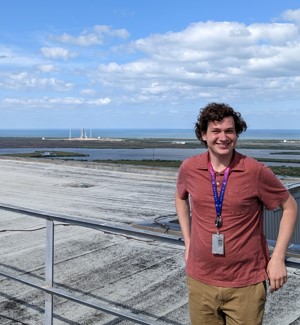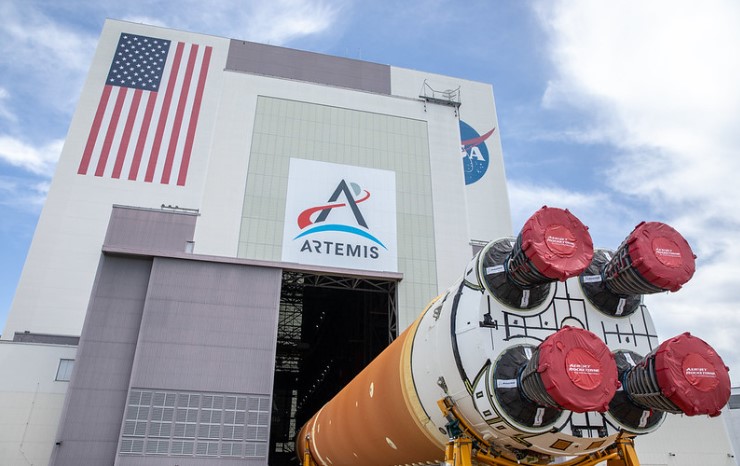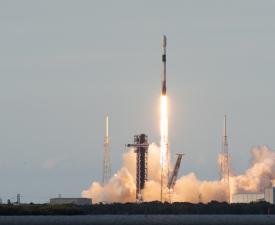

University of Virginia student Craig Kalkwarf’s career is looking up, thanks to the upcoming Artemis missions and the NASA Pathways program. The coveted internships prepare an exclusive group of advanced college students for careers at the space agency.
Specifically, Kalkwarf spends time looking up at rockets and filming them as they rise.
NASA’s Advanced Imaging Analysis Lab team at Florida’s Kennedy Space Center, where Kalkwarf works when he’s in rotation, looks for objects such as chunks of foam or ice, seemingly innocuous in everyday life, but which can be disastrous if they dislodge during liftoff.
In choosing the third-year student, double-majoring in aerospace engineering and astronomy, Pathways found a way to combine Kalkwarf’s loves, which include photography and all things mechatronic, to their advantage and his.
Kalkwarf is now back at UVA School of Engineering and Applied Science for a year. He will be returning to Kennedy next fall. That’s the earliest that Artemis II could launch its first crew. The four astronauts will be on a 10-day mission to circle the moon and test NASA’s current exploration capabilities, with the longer-term goal of establishing a lunar base.
Heading Off Potential Disasters
The Advanced Imaging Analysis Lab, which supports the coordination of image capture and review during the dynamic event of a launch, will be of vital importance to the Artemis missions as NASA strives to learn from past tragedy.
In the case of the 2003 Space Shuttle Columbia disaster, a piece of lightweight insulating foam the size of a briefcase tore free from the craft’s external propellant tank. The foam thumped into the shuttle’s left wing as the ship rose.
Columbia was one of a handful of now-defunct reusable spacecraft that were designed to rise by rocket into orbit before jettisoning the boost and gliding back down to Earth again.
The ship was not equipped to check the wing during its 16-day mission, but engineers at mission control had assumed, based on computer modeling that turned out to be a poor match, that the craft was fine. Instead, the strike had gauged protective tiles, creating a thermal-protection breach. As Columbia attempted to reenter the Earth’s atmosphere at hypersonic speed, the craft, and everyone aboard, were lost.
“It was high speed cameras that were tracking Columbia’s rocket,” Kalkwarf said. “And that's how we knew that foam hit the orbiter. And that's how the Columbia Accident Investigation Board was able to know everything about it, is from imagery.”
Now, as NASA points its sights once again toward the heavens, Kalkwarf is on the visual safety team whose cameras will be rolling. The idea is that with an earlier, fuller situational awareness, and other preparedness, future flights could be saved from falling or dislodged debris.
“That's why they want the best cameras possible, and why we're testing them,” Kalkwarf said.
Kalkwarf, of Fairfax, Virginia, explained more of the details of his job in a Q&A with UVA Engineering, including why his unit is switching from film to digital. He also related some of his other NASA experiences and talked about his path to Pathways.
Q. Can you tell us more about the Advanced Imaging Analysis Lab?
A. There are three primary functions of our lab: perform camera testing on high speed digital cameras to find a suitable replacement for the high speed film cameras currently on the pad, support the imagery console in the Launch Control Center during Artemis launches, and provide imagery analysis on Artemis launch and tests for verification and validation efforts.
The console for imagery coordination and evaluation, or “CICE,” does exactly what the acronym sounds like. We see ICE. We'll be scanning the Artemis rocket during cryo-loading. That’s when we're loading super-cold propellant into the rocket, so that we can watch for ice buildup and watch for any foam cracks that may occur. And then we’ll size the debris or any cracks or ice to identify any items of concern. We also do imagery screening. So we'll come to our lab after a launch or a test event, put it up on the big screens and bring in the subject matter experts and go through frame by frame on all these videos to make sure we really understood what just happened.
We can do motion tracking, and we can analyze the water coverage on the pad of our sound suppression system. Anything that can be measured with images, we can do it.
And then the final point is camera testing. And so that's a lot of what I've been doing.
Q. What types of cameras does NASA use, and how is that changing?
A. Not a lot of people know this, but we still use high-speed film cameras to record Artemis launches. That's because the film cameras just have some advantages that digital cameras have struggled to catch up for, and they're just starting to catch up for.
For right now we have 62 high speed film cameras and 10 high speed digital cameras on the pad to record Artemis launches or around the pad. But by Artemis IV, our Exploration Ground Systems team will replace all those film cameras with high-speed digital cameras.
One of the main advantages film has over these high-speed digital cameras is the dynamic range of the cameras. Film has so much more dynamic range than digital. It's a characteristic of the film versus the sensors on high-speed digital cameras.
We have to be able to record a launch during the day, during the night at dawn at dusk, and it has to be able to capture all the imagery.
And so our lab specifically has been doing work to test these high-speed digital cameras to determine what the best one is for each use case. Because our use case is a lot different than a lot of normal high speed digital use cases.
Q. How do you overcome the dynamic range problem?
A. Yeah, so that's exactly what my testing was for, perfect segue. We've been testing a new high-speed digital camera, and this camera has the ability to alternate between bright and dark frames every other frame. And so this camera essentially allows us to have two cameras in one where one camera's recording the bright exposure and one camera's recording the dark exposure.
Q. Can you tell us about working on those camera tests?
A. Yeah, what I've been doing with the cameras, I've been going to multiple different locations such as Kennedy Space Center’s Press Site or tracker sites around the launchpad. Tracker sites are sites where these big machines will go and deploy on mounds. Someone will sit in a seat here and we have a bunch of cameras with big lenses and telescopes on it, and they'll just follow the rocket in the sky as it goes up to get imagery of it.
We would go and deploy, we put the camera on, and someone would go sit and track the rocket as it goes up. What I would do during the launches was experiment with different camera settings to understand what the camera's capable of. And so I'd determine the settings, I'd run the software, and I'd be out in the field for the launches.
Q. What was your route into the NASA Pathways program?
A. I first took photography in high school. I just decided to take that as an elective in my freshman year of high school. I learned on black and white film. We would go to the dark room and develop our images. And so that's where I first learned photography and where I started to really discover I had a passion for photography.
So for me, how I became qualified for this was kind of not necessarily being an aerospace engineer, but by being an aerospace engineer while also having a photography background and also my astronomy education in optical astronomy, that is the same sort of thing where we're imaging things with telescopes and these advanced cameras. It's kind of the combination of all of that experience that led me here.
Q. What have been some of your most memorable NASA experiences so far?
A. I mean, I just, working at Kennedy Space Center, you get loaded with cool experiences. Like, I work in the Vehicle Assembly Building. I get to call that my office building every day. I have seen probably 30 launches in six months. I’ve gotten to see all the different launch vehicles, like the Starliner launch, I got to see the Crew-8 launch, I got to see an Axiom launch. So three human space flight missions in those six months.
Q. Any advice for other students hoping to get accepted to NASA Pathways?
A. Yeah, definitely. The one thing that's big about NASA is that if you're trying to get into Pathways, you need to really be intentional about it. You need to be paying attention specifically to it because it's unlike applying to any other internship. They only release Pathway applications two times a year. And when it's open, it's only open for a week at a time.
Luckily, when I was a first-year, I attended a presentation that had a NASA employee there. And during the Q and A, they gave some advice about Pathways and getting into NASA. One of the big things they said is don't be afraid to take the internship during a school semester, take a semester off, push your graduation back. If it's something you really want, pushing your graduation back is no big deal.

